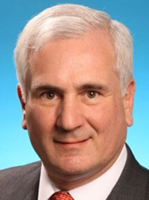Will Cyclobenzaprine Be A Solution For Fibromyalgia Patients?

By Ed Miseta, Chief Editor, Clinical Leader

Seth Lederman, M.D. has worked with many patients with fibromyalgia as a physician, and knows they have waited long enough for relief from its symptoms. “Those symptoms can quickly take over their lives,” he says. “Fibromyalgia is considered to be a pain disorder but it’s much more than that. It affects sight, sound, taste and smell. It even affects internal organs of the body. Pain just happens to be the easiest symptom for patients to describe.”
Lederman has worked as a scientist in academia (Columbia University) and a physician in a rheumatology clinic (New York Presbyterian Hospital). But what has driven him for the past 17 years of his life is finding a treatment for the debilitating disease. The molecule he is currently pursuing, cyclobenzaprine, was originally developed by Merck as a muscle relaxant. When that same molecule was later discovered to improve the sleep quality of fibromyalgia patients, he acquired the rights to it, starting a company called VELA Pharmaceuticals. When that company changed its focus and no longer wished to pursue the drug, he was able to retain the rights to it and start a new company called Krele, which later became Tonix Pharmaceuticals. Lederman currently serves as the CEO, and shares some insights on his journey for a treatment.
Ed Miseta: What options do fibromyalgia patients currently have?
 Dr. Seth Lederman: The most popular medicine currently on the market is Lyrica. This is a gabapentinoid that provides relief to patients by treating the pain symptoms. There are also SNRIs (serotonin-norepinephrine reuptake inhibitors) which are called Cymbalta and Savella. These are best known as antidepressants, but they also address pain symptoms in fibromyalgia.
Dr. Seth Lederman: The most popular medicine currently on the market is Lyrica. This is a gabapentinoid that provides relief to patients by treating the pain symptoms. There are also SNRIs (serotonin-norepinephrine reuptake inhibitors) which are called Cymbalta and Savella. These are best known as antidepressants, but they also address pain symptoms in fibromyalgia.
Miseta: How does cyclobenzaprine differ from these medicines?
Lederman: We are searching for solutions to fibromyalgia symptoms differently from the existing medicines, by attacking the sleep disorder issues that are experienced by fibromyalgia sufferers. By administering small doses of the medicine under the tongue to patients at bedtime, we believe it will be an effective long-term treatment option for patients, and our Phase 2B study was able to demonstrate its effectiveness.
If we are able to repeat and confirm the results of the Phase 2B study with our Phase 3 study that is currently underway, I think it would be hard for people to not pay attention to the molecule and the importance of the work we are doing. Fibromyalgia is an enormous problem for millions of patients, and I believe this product will fill a large unmet need even within the array of options that physicians have available to treat these patients.
Miseta: How many sites are involved in the current study?
Lederman: I believe approximately 35 sites and they are all in the U.S.
Miseta: Do you communicate with others who are involved with finding an effective treatment?
Lederman: I always felt that the FDA approval of Lyrica, which was developed by Pfizer, was a huge turning point in the search for new treatments for fibromyalgia. Oftentimes the first medicine to hit the market will spur additional research to advance the cause. I believe there’s a strong comparison between what patients of fibromyalgia are going through today and what was experienced by the early sufferers of HIV. There was reluctance by doctors to treat HIV patients because of the frustration of not being able to help them. Many physicians felt that same frustration when dealing with fibromyalgia patients before the approval of Lyrica. Now patients and physicians have hope but they are looking for better medicines with higher and higher expectations.
I admire Dr. John Martin, the CEO of Gilead, because he had a unique perspective on treating HIV. I got interested in HIV early on, when I was a medical student in the fall of 1982. The first paper on HIV came out in The New England Journal of Medicine, and it was a call to arms for physicians of my generation. I ended up working on HIV for about five years, but also followed Dr. Martin’s story with a lot of interest. He spent time at Bristol-Meyers Squibb (BMS) where he was working on some anti-viral compounds from Czechoslovakia. As I understand it, when Bristol-Meyers Squibb decided not to work in HIV, Dr. Martin went to Gilead. When he got to Gilead in 1991 he licensed the compounds from Czechoslovakia – one of which is tenofovir, which is at the heart of Gilead’s very successful products: Viread, Truvada, Atripla, Stribild and Genvoya. As importantly, with Truvada, Gilead has pioneered pre-exposure prophylaxis, which is now an important public health program. The beginning of Dr. Martin’s story at Gilead is similar to the path that I took in forming Tonix, which was to continue the research that others had also decided not to pursue. I can only hope the rest of the Tonix story will be as successful in treating fibromyalgia as Gilead has been in treating HIV.
Miseta: Do patients seem to be satisfied with the medicines currently available?
Lederman: These medicines help many fibromyalgia patients and they are FDA approved based on studies that establish their efficacy, but I think something more is needed. The big problem with fibromyalgia medicines right now is tolerability. Tolerability is particularly challenging in fibromyalgia because patients are dealing with heightened sensitivity of all of their senses: taste, smell, sight, touch – all of them. Because of their increased sensitivity, they experience side effects intensely. Also, a number of side effects of the current medicines are hard to distinguish from symptoms of fibromyalgia itself.
While the medicines on the market today are effective for many people, at some point too many patients find themselves dissatisfied with them. Many are finding that the side effects of the drugs outweigh the benefits they are getting from them.
One of the biggest advances that we are seeking with our medicine is tolerability. So far, it has shown in the Phase 2b study to be well-tolerated. It’s a prescription drug and all prescription drugs have side effects. There were some side effects in the Phase 2B study we performed. We had 86 percent of the enrolled patients complete the entire 12 weeks of therapy on the active medicine. That is high compared to the historical completion rates of the other medicines in other studies. I think that completion rate suggests that many of treated patients felt there was a benefit to staying on the medicine all the way to the end of the 12-week study.
Miseta: How are you feeling about the current Phase 3 study?
Lederman: This study will enroll more than 500 patients and we are enthusiastic about completing it. Tonix has a truly patient-centric approach. All of the considerations we put into the design and development of the product had the needs of the fibromyalgia patient in mind. I’m proud to say that we really may have something that addresses a broad array of symptoms, and that patients might be able to tolerate TNX-102 SL for long-term use. It’s a medicine that most patients enrolled in our Phase 2b study seemed to stick with, possibly because they are feeling benefits relative to the side effects and risks.
